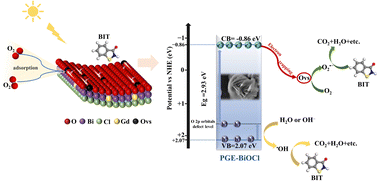Effective solar light-driven isothiazolinone degradation by morphology- and oxygen vacancy-modified Gd-doped BiOCl†
Abstract
Antibacterial isothiazolinones are refractory organic pollutants towards biodegradation, existing in reverse osmosis concentrated water and other relevant industrial wastewater, which need to be decomposed before getting discharged into a water body. Herein, we synthesized Gd-doped flower-like hierarchical BiOCl (PGE-BiOCl) with promoted visible light response using a facile solvothermal method. The pseudo-first-order rate constant of 1,2-benzisothiazolinone-3-one (BIT) degradation was enhanced 6.49-fold by PGE-BiOCl (k = 0.610 h−1) compared to BiOCl (k = 0.094 h−1) under simulated visible light. It is mainly due to the synergistic effect of abundant Ovs, highly exposed (110) dominant crystal planes, and Gd doping of PGE-BiOCl. The scavenger experiments and EPR characterizations indicated that O2˙− was the dominant radical in the degradation system. The DFT calculation further confirmed the existence of O 2p orbitals near the Fermi level, which may narrow the band gap of BiOCl and improve the charge carrier separation efficiency. This work offered a promising approach for the preparation of an effective solar light-driven photocatalyst for the degradation of refractory organic pollutants in water.



 Please wait while we load your content...
Please wait while we load your content...